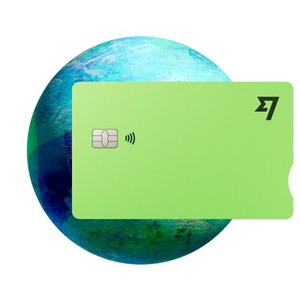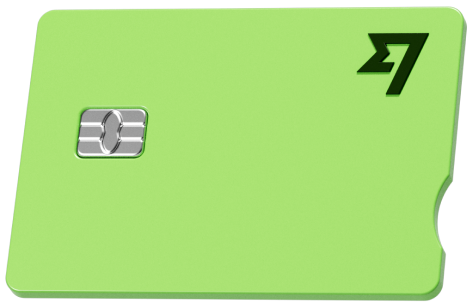The 6 Best Travel Cards for Italy in 2025

If you’re traveling to Italy, a travel money card can make spending and withdrawing cash when you’re away cheaper and more convenient. Different types of travel money cards, including travel debit cards, prepaid travel cards and travel credit cards, are available to support different customer needs. The right one for you will depend on your personal preference and how you like to manage your money.
Read on for all you need to know, including a closer look at travel money card types, some great options to consider, and the sorts of fees you need to think about when you choose.
Wise – good value debit card for Italy
Before we get into details about different travel money card options, let’s start with the Wise Multi-Currency Card as a good all-round option that allows you to hold and spend euros - the official currency in Italy - as well as a diverse range of other world currencies.
Wise accounts can hold and exchange 40+ currencies, and you can get a linked Wise Multi-Currency Card for a one time delivery fee. Top up your account in USD and switch to EUR before you travel, so you know your travel money budget in advance - or if you’d prefer, you can simply allow the card to automatically switch currencies as and when you need it. All currency conversion uses the mid-market exchange rate, with low fees from 0.43%. Plus you can get EUR bank account details - as well as local account details for USD and up to 9 other currencies - to get paid conveniently to your Wise account.
Here are some of the advantages and disadvantages of using the Wise travel money debit card, to help you decide if it's suitable for you.
| Pros of using the Wise Multi-Currency Card in Italy | Cons of using the Wise Multi-Currency Card in Italy |
|---|---|
| ✅ Hold and exchange 40+ currencies including EUR, and a selection of other world currencies ✅ No fee to spend any currency you hold, low conversion fees from 0.43% ✅ Mid market exchange rate on all currency conversion ✅ Some fee free ATM withdrawals every month ✅ No ongoing fees and no interest to pay | ❌ 9 USD delivery fee ❌ No option to earn points or rewards |

What is a travel money card?
A travel money card can be used for payments online and in stores, and for cash withdrawals, just like your regular bank card can be. However, with a travel money card you’ll find the features and fees have been optimized for international use. That might mean you get a better exchange rate compared to using your normal card overseas, or that you run into fewer fees. Some travel cards also have options to earn cashback and rewards when you use your card internationally.
6 travel money cards for Italy compared
We’ll look at each of these card options in a little more detail in just a moment, but let’s start with an overview of how 6 top travel money cards for Italy line up side by side:
| Provider | Type | Card delivery fee | Fees for spending | Exchange rate | Interest rate | Italy ATM fee |
|---|---|---|---|---|---|---|
| Wise | Debit | 9 USD order fee | Free to spend any currency you hold, currency conversion from 0.43% | Mid-market rate | Not applicable | Some free withdrawals every month based, low fees after that |
| Revolut | Debit | Variable fee based on location and account tier | No fee to spend any currency you hold, currency conversion free to plan limit, 0.5% fee after that Out of hours and exotic currency fees may apply | Mid-market rate to plan limit, 0.5% fee after that | Not applicable | Some no-fee withdrawals every month based on account tier, low fees after that |
| Bluebird American Express prepaid | Debit | Online orders are free | No foreign transaction fee | Amex rate | Not applicable | 2.5 USD |
| Discover it Secured | Credit | No fee | No foreign transaction fee | Discover rate, which may be the mid-market rate depending on the currency | Variable, 27.49% representative | 10 USD or 5%, whichever is greater |
| Capital One Venture Rewards | Credit | No fee (annual charge of 95 USD applies) | No foreign transaction fee | Network rate | 20.74%, - 28.74% variable | 3 USD or 3%, whichever is greater |
| Chase Sapphire Preferred | Credit | No fee (annual charge of 95 USD applies) | No foreign transaction fee | Network rate | 20.74% – 27.74% variable | 10 USD or 5%, whichever is greater |
As you can see, the features of different travel money cards can vary pretty widely. In general travel debit cards can be convenient and often fairly cheap to use, while travel credit cards can offer some nice perks like cashback or rewards - but do mean you might run into interest and late payment charges, depending on how you choose to pay.
Travel debit cards often let you top up a linked account online or through an app, so you can set your budget and can’t spend more than you intend. Travel credit cards on the other hand let you spend to your card limit, and then repay the amount over a few months if you’d prefer to. Which is best for you will come down to how you like to manage your money - we’ll dive into a few more details about each card type, next.
What are different types of travel cards?
Broadly speaking, US customers are able to select a travel money card from either a regular bank or a specialist provider, which may be a travel debit card, travel prepaid card or a travel credit card. We’ll walk through what each travel money card type is, and pick out a couple of good card options, so you can compare and choose.
1. Travel Debit Cards for Italy
Travel debit cards are usually offered by specialist providers, with linked digital accounts you can use to hold and convert a currency balance. While different cards have their own features, travel debit cards can usually be topped up easily online and through an app, with the option to see your balance and get transaction notifications through your phone too. That makes it easier to keep on top of your money, no matter where in the world you are.
Travel debit card Option 1: Wise
Wise is a good value travel money debit card for Italy. There’s no fee to open a Wise account, and just a small delivery fee for your Wise Multi-Currency Card, with no minimum balance and no monthly charge. You just pay low Wise fees from 0.43% when you convert currencies, and transparent ATM fees when you exhaust the monthly free transactions available with your account.
- No fee to open a Wise account, no minimum balance requirement
- 9 USD one time fee to get your Wise Multi-Currency Card
- 2 withdrawals, to 100 USD value per month for free, then 1.5 USD + 2%
- Hold EUR and 40+ other currencies, convert between them with the mid-market rate
- Get local account details to receive EUR, USD and 8 other currencies conveniently
Travel debit card Option 2: Revolut
Revolut has a selection of different account tiers, so you can simply pick the account you prefer - from Standard plans with no monthly fee, to the 16.99 USD/month Metal plan. All Revolut accounts have linked cards, although exactly what type of card you get depends on your account tier. You can hold around 25 currencies, and convert currencies with the mid-market rate to your plan’s allowance.
- No monthly fee if you open a Standard Revolut account, or upgrade for up to 16.99 USD/month
- Card delivery fees may apply depending on your account tier
- All accounts have some fee free weekday currency conversion with 0.5% fair usage fees after that. Out of hours and exotic currency fees may apply in some cases
- Standard plan holders can withdraw 400 USD overseas per month for free
- Hold about 25 currencies, including USD and EUR

Pros and cons of using debit travel cards in Italy
| Pros of using debit travel cards in Italy | Cons of using debit travel cards in Italy |
|---|---|
| ✅ No possibility to run up interest costs or late payment fees ✅ Hold and exchange currencies in advance or at the time of spending ✅ Accounts can be topped up, viewed and managed digitally ✅ Safe to use, as accounts aren’t linked to your main US bank account ✅ Travel debit cards are issued on popular global payment networks | ❌ Transaction and currency conversion fees may apply ❌ Cash back and rewards may not be available |
How to choose the best travel debit card for Italy?
The best travel debit card for Italy really depends on your personal preferences and how you like to manage your money. If you’ll be traveling widely it makes sense to look for an account with mid-market currency exchange and a large selection of supported currencies as well as EUR, like Wise. Other providers like Revolut can also be a good pick, particularly if you’ll use your account very frequently and would prefer to pay a monthly fee to unlock lots of no fee transactions and extra perks.
Is there a spending limit with a travel debit card in Italy?
Different providers set their own limits for card use. Limits may apply daily, weekly or monthly, and can apply to different types of transactions. You might find you have a limit to the amount of ATM withdrawals you can make per day, for example, or the value of contactless payments - these limits are set for security and can sometimes be managed and changed in the provider’s app.
2. Prepaid Travel Cards for Italy
With a prepaid travel card you’ll need to order a card and add funds, to pay merchants and make cash withdrawals. While prepaid travel cards are usually issued on large global networks - and can therefore be used pretty widely - not all cards are accepted globally, so you’ll need to check network coverage in your destination country.
Prepaid travel card option 1: Bluebird American Express prepaid debit card
You can order a Bluebird prepaid debit card for free online. You’ll then be able to top up in cash or from a bank account. You can also add checks or have funds deposited by others - fees apply for some top up methods. While this card doesn’t allow you to hold foreign currencies, you won’t pay a foreign transaction fee to spend your USD balance abroad, which makes it a good choice when you’re away from home.
- Get a card for free by ordering online
- Top up in a range of ways in USD
- No foreign transaction fee when spending overseas
- ATM withdrawal fees of 2.5 USD or the equivalent when overseas
- American Express cards are not always accepted internationally - check coverage before you travel
- No interest to pay

Prepaid travel card option 2: Discover it Secured
Discover it Secured is a credit card, but we’ve included it in our roundup of prepaid cards because it’s a secured card, which means you’ll need to pay an upfront deposit, and can then spend to that deposit level every month. Clear off your bill in full to avoid interest, and you could build a credit score, earn cashback and get no foreign transaction fees when you spend overseas, too.
- No annual card fee, although interest charges and late payment fees do apply
- No foreign transaction fees for spending overseas
- ATM withdrawal fees may apply including a 10 USD cash advance fee
- Earn cashback on spending and build credit as you do so
- Discover network is not always internationally supported - check your destination before you travel

Pros and cons of using prepaid travel cards in Italy
| Pros of using prepaid travel cards in Italy | Cons of using prepaid travel cards in Italy |
|---|---|
| ✅ Manage your account online or with an app, to add more money or pay off your bill ✅ Accounts with no monthly fees are available ✅ Foreign transaction fees may be waived ✅ ATM withdrawals supported globally ✅ Some accounts have extras like options to earn reward points | ❌ Network coverage on Amex and Discover may not be as strong overseas as it is in the US ❌ Transaction fees apply to most accounts |
How to choose the best travel prepaid card for Italy?
There’s no single best travel prepaid card for Italy - it’ll come down to your personal preference. If you’re looking specifically for a prepaid debit card you can use in Italy with no foreign transaction fee, try the Bluebird card option. However, if a credit card suits you, the Discover it Secured can be a strong pick thanks to the cash back options available.
Is there a spending limit with a prepaid card in Italy?
Different prepaid travel cards set their own limits for spending and withdrawals, which can vary between currencies. You’ll need to check your card’s terms and conditions carefully to make sure you pick a provider which suits your needs.
3. Travel Credit Cards for Italy
Travel credit cards typically offer some extra international features compared to regular credit cards, such as low or no foreign transaction fees or extra option to earn rewards when you’re abroad. In general, travel credit cards are safe and convenient but can be more expensive compared to using a debit card option. Before you select the right card for you it’s important to check the fees, rates, eligibility rules and interest rates which apply, so you can make sure it’s a good fit for you.
Travel credit card option 1: Capital One Venture Rewards
The Capital One Venture Rewards card has no foreign transaction fees when you spend overseas. There’s also a comparatively low cash advance fee when you use an ATM, at 3 USD or 3% whichever is higher. You’ll need to repay your bill in full every month to avoid fees and interest, but can earn travel rewards and miles on your day to day spending.
- No foreign transaction fee
- Earn travel rewards on spending
- Get extras like lounge access and free travel insurance
- International spending uses the network exchange rate
- Variable interest rates which apply if you don’t pay off your bill in full

Travel credit card option 2: Chase Sapphire Preferred
The Chase Sapphire Preferred card has a variable interest rate with no foreign transaction fee to pay. However, you’ll need to pay a 95 USD annual card charge to get your card in the first place. Currency conversion uses the network exchange rate - plus there are benefits and rewards available for cardholders.
- Variable interest rates and a 95 USD annual fee
- Check your eligibility and order a card online easily
- No foreign transaction fee
- Network exchange rates apply

Pros and cons of using credit cards in Italy
| Pros of using credit cards in Italy | Cons of using credit cards in Italy |
|---|---|
| ✅ Spread the cost of your travel over several months ✅ Check eligibility for a card online with no impact on your credit score ✅ You may pay no foreign transaction fee ✅ Network exchange rates usually apply, which are usually pretty fair | ❌ Interest charged if you don’t repay in full every month ❌ Eligibility rules apply |
How to choose the best travel credit card for Italy?
The best travel credit card for Italy will depend on your personal preferences. If you’re interested in earning rewards and cash back on your overseas spending, a travel rewards card like the Chase Sapphire Preferred could be a good bet as it has no foreign transaction fee and offers rewards on all spending. Whichever card you’re considering you’ll want to weigh up the potential fees you’ll need to pay against the rewards you can earn to make sure it’s worthwhile.
Which cards are accepted in Italy?
It’s important to know that you may find that different card networks are more popular in one country than they may be in another. For example, while Visa and Mastercard are pretty widely accepted globally, other popular US card networks, like American Express and Discover cards are less likely to be accepted in some countries and regions. In most cases it’s best to carry more than one means of payment when you travel - for example a credit card and a specialist travel money card which has been issued on a different network - so that you always have a plan B if your preferred payment method isn’t available.
Related: How to get Euros in the US
Conclusion: Which travel money card is best for Italy?
If you’ve planned travel to Italy you might want to pick a travel money card for EUR spending. Travel money cards have different features, and can be picked up via regular banks or online specialists.
You could opt for a low cost travel debit card which comes with a linked account to hold a selection of currencies - like the Wise Multi-Currency Card. Or you might prefer a prepaid travel money card like the Bluebird American Express debit card which can be linked to a fee free account. Finally, another option is to get a travel credit card either to earn cashback and rewards, or to avoid foreign transaction fees.
Use this guide to start your research and pick the right option for your specific needs.
FAQs - Best travel cards for Italy 2025
1. Which card is best to use in Italy?
There’s no single best card to use in Italy. Which is right for you will depend on your preferences and the features you want to access. Having a multi-currency account from a provider like Wise or Revolut can be a good bet as you’ll be able to hold and exchange EUR alongside dozens of other major currencies for convenience.
Related: Best Euro cards
2. What is the best way to pay when traveling in Italy?
Spending with your card is convenient when traveling in Italy, but you’ll be best off having several different payment methods just in case your first choice isn’t supported. For example, you could choose 2 different debit or credit cards, issued on different networks, and you could also get euros in advance so you have some cash on you for those times when cards aren’t available.
3. Can you withdraw cash with a credit card in Italy?
You can usually make cash withdrawals with a credit card in Italy at any ATM that supports your card network. You’ll often find that a fee applies, and you may start to accumulate interest on the withdrawn amount immediately. Travel money debit cards from providers like Wise and Revolut can be a lower cost option for cash withdrawals in EUR.
4. Can I use a US card in Italy?
You can use your US card anywhere you see the card network’s logo displayed. Visa and Mastercard networks are very well supported globally, including in Italy, making these good options to look out for when you pick your travel debit card for Italy.
5. Are prepaid cards safe?
Prepaid cards from reputable providers are safe to use at home and abroad. They aren’t linked to your main bank account which can offer extra peace of mind, and may also make it easier to manage your travel budget. However, you’ll need to check the card features and fees carefully to make sure you're getting the best match for your needs.
6. What are the main fees for travel cards when traveling?
The fees applied for travel cards can vary widely depending on the provider and the card type. With debit cards you may find ATM fees, and costs for converting currencies, although specialist providers like Wise and Revolut have linked multi-currency accounts which can bring down the costs of currency conversion. Credit card fees include cash advance charges, foreign transaction fees and interest.


